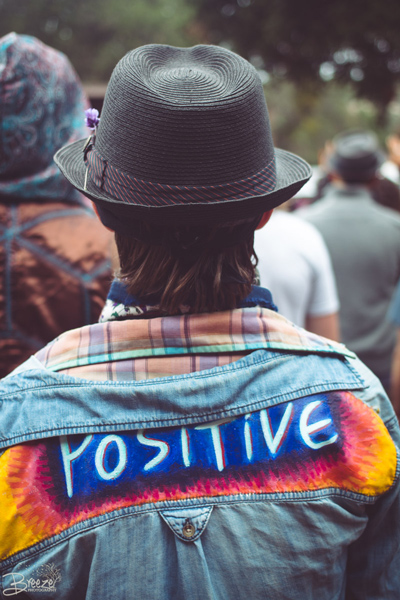
It sounds easy. And it’s mildly infuriating. “Just be positive!” they’ll say, “fake it ‘til you make it!” And you’ll plaster on a fake smile and wonder why you’re supposed to be happy when it’s incongruent with how you actually feel.
While we try to create a space for positive experiences at Lucidity Festival, we’re also skeptical of the need to view every problem in the world with silver-linings.
Instead of just looking at everything through rose-tinted glasses, how do you actually create more positivity in your life without just pretending that everything is fine and dandy?
A Return to Eudaimonia
In a previous post, we dug into the definition of Eudaimonia. If you’re just jumping into the story, eudaimonia is all about discovering your personal legend and living a moral and virtuous life. Philosophy describes it as the state of “fulfillment, living a good (moral) life, human flourishing, and moral or spiritual success”.
Our experience at Lucidity this year is destined to create space for new project ideas and paths toward our personal legends. But how do we make sure we aren’t limiting ourselves to our own limited imaginations?
This legend-seeker recommends using positive affirmations as a tool to reach eudaimonia.
What is a positive affirmation?

Positive affirmations originated in the 1970’s when two neuroscientists at UCSC used their understanding of linguistics and psychotherapy to “theorize that success can be achieved by increasing positive behaviors and decreasing negative ones”.
This seems like a no-brainer, but when we let our minds process possibility unchecked, we are riddled with anti-social impulses. In sneaks The Fear. He leaves the door open for self-doubt.
So let’s take, for example, the positive affirmation: I release the past with ease.
The use of the first person is important. You’re changing a limiting belief about yourself in order to let go of old patterns. You’re allowing the brain to build new synaptic connections. The rigidity or adaptiveness of your brain to new stimuli is called neuroplasticity.
By using positive affirmations, you are increasing your neuroplasticity. You are allowing your brain to become more receptive to new ways of thinking, such as empathy and intuition.
How do people use them?

Positive affirmations are usually motivational sentences that speak to something we want in our lives. The trick is that they’re phrased as if we already have them. When repeated every day, many people believe they can use affirmations to “consciously rewire thought patterns towards more desired outcomes”.
Changing a habit isn’t easy, and negative behaviors have an absurd amount of control over our habits. When you have something you want to do and you start by going through a list of all the reasons why it won’t happen, you’re allowing negative thoughts to stop you before you even start.
If we incorporate positive behaviors into our lives through affirmations, we decrease the chances of negative behaviors stopping us from being successful. When you say “I can” instead of “I can’t,” you’re naturally increasing your confidence and setting yourself up for success.
But saying “I can” will only take you so far. The most effective positive affirmations are ones that you believe can actually happen. It’s also important to make them specific and personal so they resonate with you. Let’s walk through how you can create specific and believable affirmations that will work for you.
How do I find an affirmation that works for me?
There are plenty of affirmations on the internet that you can adopt as your own. Inspired by the work of Louise Hay, this blogger wrote 101 affirmations for a variety of situations and emotions. You’re sure to find at least a few that resonate with you.
If you’re interested in writing an affirmation that’s personalized just for you, try these tips to get started:
- Think of a negative behavior you want to change about yourself, then write an affirmation that focuses on the opposite of that behavior. If you’re thinking “I’m always too tired to work on achieving my goals”, write something like “I take time to rest so I have energy to achieve my goals.”
- Read your affirmation out loud. Does it sound like something you would say? If not, rewrite it in your own voice.
- Write in the present tense. An effective affirmation is a phrase you can say for the rest of your life without it getting old. Do this by writing your affirmation as the outcome of a goal rather than the journey to achieve it. For example, “I can love others because I love and accept myself first”.
- Focus on the positive habits you gain rather than the things you take away from your life. Instead of saying “I don’t argue with my family anymore”, maybe say “I listen to and empathize with my family”.
- Write some of your affirmations about the success you’ve already achieved in your life. This will remind you that you’re already well on your way to success and help you buy in to the rest of your affirmations.
- Listen to music while you write your affirmations. It helps to play something that evokes emotion. Need help picking a playlist? Check out Lucidity on SoundCloud.
- Write as many as you want. There’s no limit to the positivity!
Now that I have an affirmation, how do I use it?

Repetition is key. Most sources recommend repeating your affirmation at least twice a day. Here are a few techniques that work for me:
- Download an affirmation app like My Affirmations to get digital reminders throughout the day.
- Use one of your affirmations as a focus for a 5-10 minute meditation.
- Repeat your affirmation out loud while you’re getting ready in front of the mirror so you can look at yourself and speak with confidence.
- Write your affirmation on paper 20 times.
- Visualize yourself in a situation where you’re embodying your affirmation.
- Review your affirmations once a month and update them as you achieve your goals.
Lindsay Dilworth
I grew up in the lush forests of Portland, Oregon where I fell in love with mother earth. Then I adventured to San Luis Obispo and discovered Lightning in a Bottle and Lucidity. Now I see life as an infinite playlist that constantly evolves with my pursuit of happiness. Let’s dance.


